New Chromatography Columns and Accessories for 2020
LCGC North America
We explore what’s new in the liquid chromatography columns and accessories commercially released over the past year.
Our annual review of new liquid chromatography columns and accessories, introduced at Pittcon and other events.
This article covers liquid chromatography columns and accessories commercially released after Pittcon 2019 through this year’s conference held in Chicago, Illinois.
LCGC
sent out a survey in late 2019 and early 2020, asking vendors to supply information on products launched after Pittcon 2019. Other areas of interest such as gas chromatography, chromatographic instrumentation, and sample preparation will be covered in other articles published in this and next month’s issues. Information for this article is obtained over the course of many months, and thus it is possible that some information has been missed or misinterpreted. The reader is encouraged to check with specific vendor sites for additional products, as well as more detailed information on product usage and attributes.
The vendors that responded to the survey with high performance liquid chromatography (HPLC) or ultrahigh-pressure liquid chromatography (UHPLC) columns and liquid chromatography (LC) accessories are listed in Table I. The products launched over the past year vary in targeted analyte type, as well as mode of operation. The entries can be initially categorized as addressing small molecule or large molecule needs. Within these categories, the products can be further separated based on the specific modes of separation they employ, including reversed-phase, hydrophilic-interaction chromatography (HILIC), chiral, and ion-exchange (IEC) chromatography. In addition to new chromatography columns, several vendors have released accessories, as well as new column formats, to address the needs of separation scientists. Trends noted throughout the article are based on comparisons to yearly reports since 2016 (1–4).
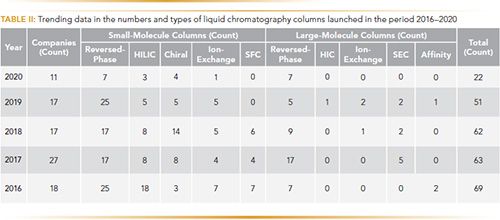
Upon examination of Table I, it is immediately apparent that there was a low number of respondents in 2020 compared to previous years. Table II shows this more clearly by providing a listing of the number of companies and the products they launched over the past five years aimed at specific categories. Please note that many products can be categorized in multiple areas, depending on usage. This is meant to be a loose interpretation to highlight trends only. The number of companies that provided new product information dropped from a high of 27 in 2017 to just 11 in 2020. Even more striking is that the number of total new column phases launched dropped from an average of about 60 columns per year over the past four years to just 22 this year. It will be interesting to see if these trends continue in the future.
Columns for Small Molecules Reversed-Phase, HILIC, and IEC
The product offerings assigned to the small molecule category intended for reversed-phase, HILIC, and IEC are listed in Table III. A total of 11 new entries are shown. Within this broad category, ChromaNik Technologies has launched the most new products. SunArmor NH2 is described by the company as a highly stable and retentive aminopropyl phase with hydrophilic endcapping. The column is suggested for the analysis of sugars and other polar compounds. The company also released SunShell HILIC-S, described as a bare silica phase built on a superficially porous particle (SPP) that is suitable for polar compound analysis. Agilent Technologies also released a HILIC phase. The company applied their zwitterionic surface chemistry previously built on a 2.6-µm SPP to their 1.9 and 4 µm SPP sizes. These three phases constitute all of the HILIC phases released this past year. As noted in the 2019 edition of this article series, HILIC phase development slowed significantly. This trend continued in 2020.
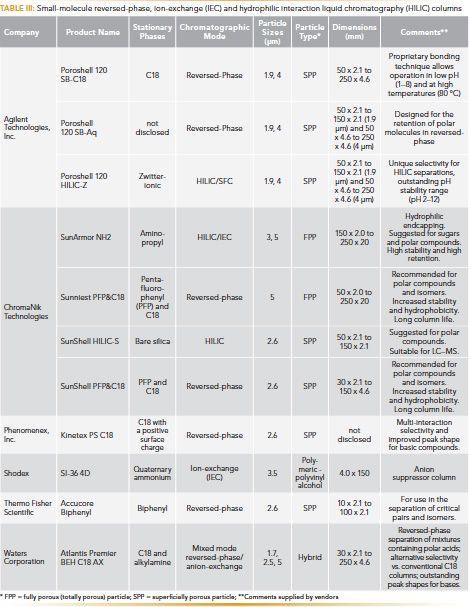
ChromaNik Technologies also developed two new columns based on a mix of octadecyl (C18) and pentafluorophenyl (PFP) ligands. The SunShell PFP&C18 is constructed on a 2.6-µm SPP particle, whereas the Sunniest PFP&C18 column uses a 5-µm fully porous particle (FPP) architecture. The company reports that the combination of ligands provides increased retention and stability, while maintaining much of the selectivity of a PFP phase. In addition to the new phases noted, ChromaNik Technologies also released many of its SunShell line of phases in capillary dimensions. The phases include C18, RP-Aqua, phenyl, C8-30HT, and C4-100 and are available in dimensions from 50 x 0.075 mm to 150 x 0.5 mm. Particle sizes of 2.0-, 2.6- and 5-µm may be acquired.
Phenomenex launched an alkyl C18 phase with a positive surface charge based on its 2.6-µm SPP particle. The Kinetex PS C18 is suggested for reversed-phase analysis of basic compounds. The company notes that the phase exhibits multi-interaction selectivity and improved peak shape for bases. The phase is also purported to provide unique selectivity. Continuing the trend of modified C18 phases, Waters Corporation released the Atlantis Premier BEH C18 AX phase. The stationary phase is described as a “C18 and alkylamine,” and is suggested for separations containing polar acids or where alternative selectivity to other C18 phases is required. The phase exhibits increased retention for polar acidic compounds as a result of a mixed mode (reversed-phase/anion exchange) mechanism. The company also claims high batch-to-batch reproducibility and a wide (2–10) pH stability range.
Agilent Technologies also released two new phases on its 1.9- and 4-µm SPP for reversed-phase operation. The SB-C18, according to the company, possesses a proprietary bonding chemistry that allows for operation down to pH 1 and is stable to temperatures as high as 80 °C. Another phase denoted as SB-Aq is claimed by the organization to provide superior retention and peak shape for polar compounds that are poorly retained on traditional reversed-phase materials. The SB-Aq phase is also touted as being stable at low pH and high temperatures.
To round out the reversed-phase, small-molecule offerings from this past year, Thermo Fisher Scientific introduced a biphenyl chemistry to its Accucore line of stationary phases. The company recommends the biphenyl phase for use in the separation of critical pairs and isomers. The phase is touted as being suitable for the determination of drugs of abuse or steroids, providing unique selectivity for aromatic and moderately polar analytes. The Accucore series is based on SPP technology.
Ion-exchange chromatography (IEC) exploits strong interactions between opposite charges of a surface and an analyte. For the analysis of small ionic compounds, polymeric supports are often modified to carry permanent (strong cation- or anion-exchange) or variable (weak cation- or anion-exchange) charge that can be used to interact with and separate analytes with the opposite charge. Only a single product was released this year in this category, the Shodex SI-36 4D column. The column is described as a quaternary ammonium functional group attached to a polyvinyl alcohol particle of 3.5-µm, and is suggested for use as an anion suppressor device. Suppressor columns act to lower the conductivity of the eluent in an IEC system to enhance the signal from the conductivity of the analytes reaching the detector.
Chiral Chromatography
Table IV provides information on columns introduced this year intended for chiral separations. As shown in Table II, the number of chiral stationary phases (CSPs) is similar to those released in the previous year, but substantially less than the number reported in 2018. Similar to last year, all newly released chiral phases were based on polysaccharide stationary phases. In addition, like in 2019, all of the chiral phases released this past year were developed on fully porous particles, reversing the trend noted in 2018 of CSPs based on SPP architecture.
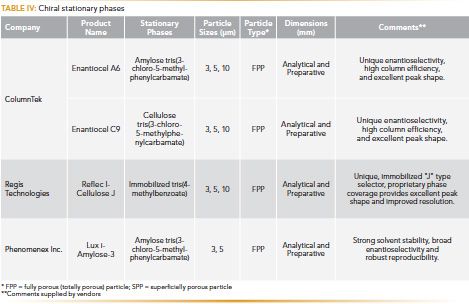
A company new to the article series, ColumnTek, introduced two new CSPs. Enantiocel A6 is an amylose tris(3-chloro-5-methylphenylcarbamate) phase built on 3-, 5-, and 10-µm FPP particles. The Enantiocel C9 offering is the identical ligand attached to a cellulose structure with the same particle size availability. Both phases are supplied from analytical to preparative dimensions, and are purported to provide unique selectivity, high column efficiency, and excellent peak shapes.
Phenomenex launched Lux i-Amylose-3 CSP. The column is based on amylose tris(3-chloro-5-methylphenylcarbamate) modification and is noted as having strong solvent stability, broad enantioselectivity, and
robust reproducibility.
Regis Technologies released a new line of CSPs called Reflect Polysaccharide Chiral columns that was reported in the 2019 article. Adding to that line, the company launched Reflect I-Cellulose J Polysaccharide Chiral Column this past year. The phase is described as a tris(4-methylbenzoate) ligand attached to a cellulose backbone. The immobilized stationary phase is note to be a “J” type selector. The columns are available in analytical and preparative dimensions and particle sizes. The company notes that a unique, proprietary, phase coverage provides excellent peak shape and improved resolution versus leading chiral phases.
Columns for Large Molecules
New columns introduced since Pittcon 2019 intended for large-molecule separations are provided in Table V. The categorization was done loosely based on the pore size of the base particles employed. Columns using particles with pore sizes of 300 Å and greater are often constructed to enable large molecules to easily access the internal structure of the particles. The data in Table II show that only phases in the reversed-phase category of large-molecule separations were released this past year (included in this was one unique 300 Å HILIC phase). In previous reports, columns utilizing different modes of separation such as hydrophobic interaction chromatography (HIC), size-exclusion chromatography (SEC), IEC, and affinity have been noted. The overall yearly number of large molecule offerings is down substantially from a height of 22 reported in 2017.
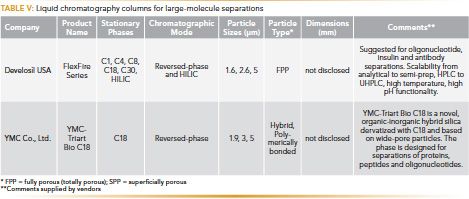
Develosil released a new line of columns branded as FlexFire. The series includes bonded phases of C1, C4, C8, C18, C30, and HILIC based on fully porous silica particles ranging from 1.6 to 5 µm with 300 Å pores. The company states that its value and performance lies in its high quality silica and 40 years of manufacturing experience. The new columns are suggested for oligonucleotide, insulin, and antibody separations. Develosil claims scalability from analytical to semipreparative dimensions, as well as high temperature and high pH functionality for its phases.
The other entry for this report is the YMC-Triart Bio C18. The column is based on a C18 polymerically bonded to a hybrid silica with a pore size of 300 Å. The new phase complements a 300 Å C4 surface chemistry already introduced. The company states that the column is designed to separate proteins, peptides, and oligonucleotides, and is particularly suited for biomolecules with a molecular weight >10,000 Da. The unique bonding and surface chemistry provides a wide usable pH range and high
temperature durability.
Accessories
Accessories are important products that facilitate, and often enable, liquid separations. Products introduced in the past year that fit this category are listed in Table VI. DWK Life Sciences released a line of user–filled gel filtration columns under the brand name Chromflex. The reusable standard or jacketed columns range in volumes from 12 mL to 2 L. The borosilicate glass barrel offers purity and strength with flangeless high-density polyethylene (HDPE) endfittings. Accessories such as flow adapters, bed support frits, valves, fittings, and tubing adapters are available according to the company.
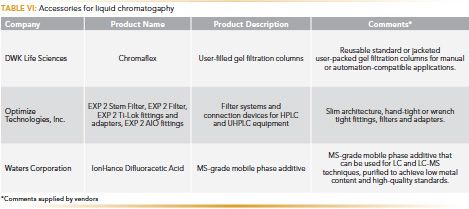
Optimize technologies launched several additions to its prefilter and connection lines of products. The EXP2 Stem Filter is described as a slim device ideally suited for the protection of expensive UHPLC columns, injectors, autosamplers, and mass spectrometer (MS) electrospray tips, without added extracolumn effects. The device may be hand-tightened, which seals up to 8700 psi, or wrench-tightened, to withstand pressures up to 20,000 psi. The company’s new EXP2 Filters provide added protection at back pressures up to 20,000 psi, with a redesign that offers more cost-efficient cartridges. In the category of connection devices, the company released EXP2 Ti-Lok and EXP2 Ti-Lok All-In-One (AIO) fittings. The first mentioned product is noted by the company as ideal for making HPLC and UHPLC connections that easily fit into tight spaces. The fittings feature built-in PEEK ferrules and threaded nuts precision machined from titanium. The device allows for repeated use, adjustment of the tubing to different port depths, and includes a removable, knurled torque driver for hand tightening and loosening. When more room is available for making connections, the company recommends the all-in-one (AIO) format, where the driver is permanently fixed.
Finally, Waters Corporation released IonHance Difluoroacetic Acid mobile phase additive. The MS-grade mobile phase additive can be used for liquid chromatography (LC) and LC–MS techniques. The product is reported to be purified to achieve low metal content and high-quality standards. The company notes that the product improves sensitivity, retentively, and peak shapes, and is quality-control tested, to ensure low metal content and high purity. The material is available in approximately 1 mL quantities in chemically resistant vials to maintain high levels of purity.
Conclusions
Liquid chromatography columns that were introduced this past year were largely product line extensions or alternatives to offerings existing on the market. One trend of introducing alkyl phases with alternative selectivity that has been noted in the past several yearly reports continued in 2020 (C18/PFP mixed ligands and charge-modified C18 phases). The most striking learning from the effort this year, however, was the drastically reduced number of products released. The decline was observed in the number of companies that reported product launches, as well as in all categories generally used to parse and discuss interesting aspects of the new releases. It will be interesting to see if the trend continues. What it may take is a breakthrough technology or a new market trend to emerge. The development of SPP architecture, for example, drove LC product development for several years following its introduction. Another recent product driver was the migration of the pharmaceutical market toward biotechnology. This resulted in many new product lines based on larger pore particle technology, as well as the resurgence of techniques like IEC and SEC. Is there another innovation or market driver on the horizon?
Acknowledgments
Products reviews such as the present work would not be possible without the contributions and cooperation of the manufacturers that have responded to the LCGC survey. Your effort is greatly appreciated. Although LCGC has made every attempt to include every submission in the series of review articles, it is possible that some have been missed. If there have been omissions, or if you want to be sure to be included in the 2021 review series, please
contact Laura Bush, Editorial Director, LCGC North America at lbush@mjhlifesciences.com.
References
- D.S. Bell, LCGC North Am. 34(4), 242–252 (2016).
- D.S. Bell, LCGC North Am. 35(4), 226–239 (2017).
- D.S. Bell, LCGC North Am. 36(4), 234–247 (2018).
- D.S. Bell, LCGC North Am. 37(4), 232–243 (2019).

David S. Bell is a director of Research and Development at Restek. He also serves on the Editorial Advisory Board for LCGC and is the Editor of “Column Watch.” Over the past 20 years, he has worked directly in the chromatography industry, focusing his efforts on the design, development, and application of chromatographic stationary phases to advance gas chromatography, liquid chromatography, and related hyphenated techniques. His main objectives have been to create and promote novel separation technologies and to conduct research on molecular interactions that contribute to retention and selectivity in an array of chromatographic processes. His research results have been presented in symposia worldwide, and have resulted in numerous peer-reviewed journal and trade magazine articles. Direct correspondence to: LCGCEdit@mmhgroup.com

New Study Reviews Chromatography Methods for Flavonoid Analysis
April 21st 2025Flavonoids are widely used metabolites that carry out various functions in different industries, such as food and cosmetics. Detecting, separating, and quantifying them in fruit species can be a complicated process.
Extracting Estrogenic Hormones Using Rotating Disk and Modified Clays
April 14th 2025University of Caldas and University of Chile researchers extracted estrogenic hormones from wastewater samples using rotating disk sorption extraction. After extraction, the concentrated analytes were measured using liquid chromatography coupled with photodiode array detection (HPLC-PDA).

.png&w=3840&q=75)

.png&w=3840&q=75)



.png&w=3840&q=75)



.png&w=3840&q=75)







